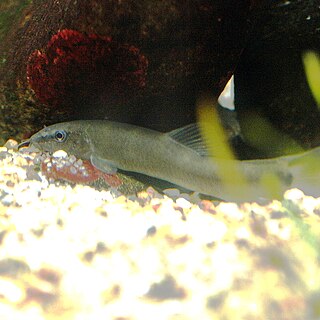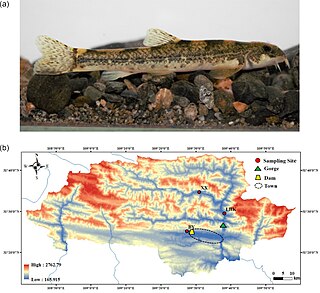
The stream catfishes comprise the family Akysidae of catfishes.

The Ayumodoki or Kissing Loach is a species of ray-finned fish in the family Botiidae. It is found in lakes and streams on Honshu, the largest island of Japan. Spawning grounds for kissing loach are ditches and small reservoirs for rice cultivation of a river system located in Japan. The kissing loach migrates to flooded areas, including paddy field areas, for spawning in early summer and the spawning of this species is limited after the formation of flooded areas over terrestrial vegetation. These flooded areas are the result of water from mountain streams and irrigation ponds flooding once dry land which create creating man-made wetlands. As, adults, Parabotia curtus migrate from these flooded paddy fields to fast moving, muddy streams and rivers like the Yodo River.

The stone loach is a European species of fresh water ray-finned fish in the family Nemacheilidae. It is one of nineteen species in the genus Barbatula. Stone loaches live amongst the gravel and stones of fast flowing water where they can search for food. The most distinctive feature of this small fish is the presence of barbels around the bottom jaw, which they use to detect their invertebrate prey. The body is a mixture of brown, green and yellow.
Oxynoemacheilus galilaeus also known as the Galilean Stone Loach is a species of stone loach in the family Nemacheilidae native to Israel and Syria.

Triplophysa is a genus of fish in the family Nemacheilidae found mainly in and around the Qinghai-Tibet Plateau in China. Currently, the genus is a mixed assemblage of species. Some lineages have been identified and treated as subgenera, but as Wikipedia follows Fishbase for fish species all but Hedinichthys have been treated as subgenera in Wikipedia, although Kottelat in his revision of the loaches did recognise them as valid. FishBase, however, includes these in Triplophysa without specifying subgenera and treats the names given by Kottelat as synonyms.
Yunnanilus macrogaster is a hypogean species of stone loach endemic to China. This species is endemic to the endorheic drainage system which feeds the Datangzi Marsh in Luoping County, Yunnan, the marsh has been formed by the outflow of a stream from its underground course. It is a demersal species and the waters where it was found were densely vegetated, it feeds on worms and insects. It is sympatric with Yunnanilus niger and Y, paludosus, forming a small species flock. It lays eggs which is does not guard.
Yunnanilus pulcherrimus is a species of ray-finned fish, a stone loach, in the genus Yunnanilus. It is found in the Hongshuihe River, part of the Xijiang River basin in China, with the type locality in Du'an County, Guangxi. The specific name pulcherrimus means most beautiful and is a reference to the “unique” banded color pattern ofthin vertical stripes crossing a wide lateral band, when compared to related species.
Triplophysa angeli is a species of stone loach in the genus Triplophysa. It is endemic to the Yalong River in Sichuan, China. It grows to 12.9 cm (5.1 in) SL.

Triplophysa bleekeri is a species of stone loach in the genus Triplophysa. It is endemic to China. It grows to 8.2 cm (3.2 in) TL. Having a wide distribution across the Qinghai-Tibet Plateau, it lives in fast-flowing rivers from 200 to 3,000m in altitude. Being an unusual species inhabiting high-altitude regions, it is an excellent model to investigate the genetic mechanisms of adaptation to the local environment. With this in mind a chromosomal-scale genome assembly was sequenced and assembled with a genome size of ∼628 Mb. This data finding that the Triplophysa genus likely diverged when the Qinghai-Tibet Plateau elevated by >4,000 m roughly 40 million years ago.
Triplophysa longipectoralis is a cave-living species of stone loach with vestigial eyes. The fish lives in clear water at temperatures below 20 °C. The holotype was caught in Xunle town, Huanjiang Maonan Autonomous County in the Liu River basin, Guangxi, China and was described by Zheng et al. in 2009.
Triplophysa siluroides is a large species of stone loach, which is endemic to the upper parts of the Yellow River basin in the Chinese provinces of Qinghai, Gansu and Sichuan.

The Tibetan stone loach is a species of ray-finned fish in the family Nemacheilidae. The specific name is sometimes spelled stoliczkae but the original spelling used by Steindachner is stoličkai. It is found in southern and central Asia.
Climacoporus navalis, the fleet klipfish, is a species of clinid found in subtropical waters of the Atlantic Ocean along the coast of South Africa where it can be found in tide pools. This species can reach a maximum length of 7 centimetres (2.8 in) TL. It is currently the only known member of its genus.
Paracobitis is a genus of Asian stone loaches.

The Nemacheilidae, or stone loaches, are a family of cypriniform fishes that inhabit stream environments, mostly in Eurasia, with one genus, Afronemacheilus found in Africa. The family includes about 790 species.
Tarimichthys is a subgenus of stone loach genus Triplophysa native to China which contains two species. Some authorities recognise Tarimichthys as a valid taxon.
Schistura scripta, is a species of ray-finned fish in the genus Schistura, newly identified from Sri Lanka. It is the third species of Schistura stone loach described from Sri Lanka, the other being the widely distributed native species Schistura notostigma and endemic Schistura madhavai.

Triplophysa ferganaensis, known as the Fergana stone loach, is a species of ray-finned fish in the family Nemacheilidae. It is endemic to the Shohimardonsoy stream in Fergana Valley, Uzbekistan. It lives in fast-flowing rivers over 1500m in altitude.
Triplophysa daochengensis is a species of stone loach in the genus Triplophysa. It is endemic to the Daocheng River in Sichuan Province, China. This species reaches a length of 9.8 cm (3.9 in)
Triplophysa wulongensis is a species of ray-finned fish in the genus Triplophysa endemic to Chongqing, China.





